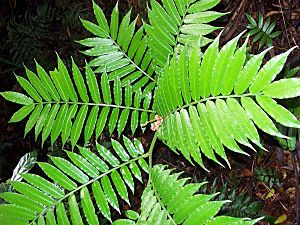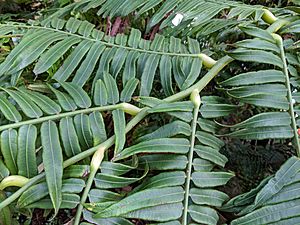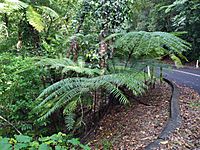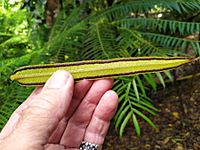Giant fern facts for kids
Quick facts for kids Giant fern |
|
|---|---|
 |
|
 |
|
| Scientific classification | |
| Genus: |
Angiopteris
|
| Species: |
evecta
|
| Synonyms | |
|
See Synonyms section below |
|
The Angiopteris evecta is a truly giant fern. It's often called the King fern, Giant fern, or Elephant fern because of its huge size. You can find this amazing plant in parts of Southeast Asia and the western Pacific. It has also spread to places like Hawaii, Jamaica, Costa Rica, and Cuba. People in different countries have their own names for it, like 莲座蕨 (lian zuo jue) in Chinese or fougère royale in French.
Contents
About the King Fern
The King fern is an evergreen plant, meaning it stays green all year. It has very large fronds, which are like giant fern leaves. These fronds can grow up to 2.5 meters (8.2 feet) wide and an incredible 9 meters (29.5 feet) long! That's longer than some school buses. The stem of each frond, called a petiole, can be up to 2 meters (6.6 feet) long itself. Many people say these are the longest fern fronds in the world.
How it Grows
The fern has a thick, trunk-like stem called a rhizome. This rhizome can be as wide as 1 meter (3.3 feet). The older parts of the rhizome lie on the ground. But the newer parts can grow upwards, reaching about 1.2 meters (3.9 feet) tall. The fronds grow out from the top of this trunk.
Even though the fronds are huge, they don't have strong woody parts. Instead, they stand up because of the water pressure inside their cells. This is like how a balloon stays firm when it's full of air. At the base of each frond, where it connects to the trunk, there are two flat, ear-shaped parts called "auricles." These can be 10 to 15 centimeters (3.9 to 5.9 inches) long.
Fern Spores
On the underside of the fronds, you can find tiny clusters of spore cases called sporangia. These are how the fern reproduces. They are located very close to the edges of the smaller leaf parts.
Naming the King Fern
The scientific name for this fern is Angiopteris evecta. It is the main example for the group of ferns called Angiopteris. A scientist named Georg Forster first described it in 1786, calling it Polypodium evectum. Later, in 1796, Georg Franz Hoffmann gave it its current name.
This fern has many different scientific names, which are called synonyms. This happens when different scientists describe the same plant under different names. Scientists are still studying if some of these names might actually be for slightly different types of ferns.
What the Name Means
The name Angiopteris comes from two Ancient Greek words. Aggeion means "vessel" or "container," and pteris means "fern." The second part of the name, evecta, comes from a Latin word meaning "swollen" or "inflated." This might refer to the swollen bases of its frond stems.
How Old is This Fern?
Scientists have found fossils of plants that look very similar to the King fern in ancient rocks. These fossils show that ferns like Angiopteris evecta have been around for about 300 million years! This makes it a very old type of plant. The fact that it's found in different, faraway places today suggests that the climate used to be much warmer and wetter in more areas in the past.
Where the King Fern Lives
The King fern is originally from Southeast Asia, including countries like Singapore, Indonesia, Papua New Guinea, and Australia. It also grows across islands in Melanesia, Micronesia, and Polynesia. Over time, it has been introduced to other tropical parts of Asia, Madagascar, and some areas in North and South America.
Its Favorite Home
This fern loves to grow in very rich soil, especially soil that comes from volcanoes. It needs a very warm and wet climate to thrive. You'll often find it growing under the taller trees in thick rainforests. It particularly likes places along creek banks in deep, sheltered valleys. These spots usually have good drainage but also plenty of fresh water. The fern prefers temperatures between 19 and 27 degrees Celsius (66 to 81 degrees Fahrenheit). It also needs a lot of rain, from 1000 to 5447 millimeters (39 to 214 inches) each year. It can grow from sea level up to 1500 meters (4921 feet) high.
Uses of the King Fern
People have used the King fern for different purposes over time. The starchy rhizomes (the thick underground stems) can be eaten. However, they need a lot of processing to remove any harmful substances first. People have also used parts of the fern to make coconut oil smell nice, to flavor rice, and even to make a special drink. In Australia, Indigenous Australians used to eat the soft inner part of this fern.
Protecting the King Fern
The conservation status of the King fern can be different depending on where you are. For example, in Australia's Northern Territory, it's considered vulnerable, meaning there are only a few small groups left. In New South Wales, it's even more rare and is listed as endangered. This is because there's very little suitable habitat left there. However, in Queensland, where there's lots of good habitat, it's not a concern and is listed as "least concern." This shows how important it is to protect its natural homes.
When it Becomes a Problem
Sometimes, when the King fern is brought to a new area with a suitable climate, it can grow too well. It can spread quickly and form thick patches, which can stop other local plants from growing. This is why it's considered an invasive species in places like Costa Rica, Cuba, Jamaica, and Hawaii. In these areas, it originally escaped from gardens where it was planted. It has escaped from cultivation in many other tropical countries too.
Images for kids
-
On the Alexandra Range near Cape Tribulation, Australia
-
Growing at Garfield Park Conservatory. The swollen bases of the petioles are clearly seen here, as are the rounded stipules
-
Underside of pinnules, showing sporangia and the swollen basal attachment. Royal Botanic Garden, Sydney












